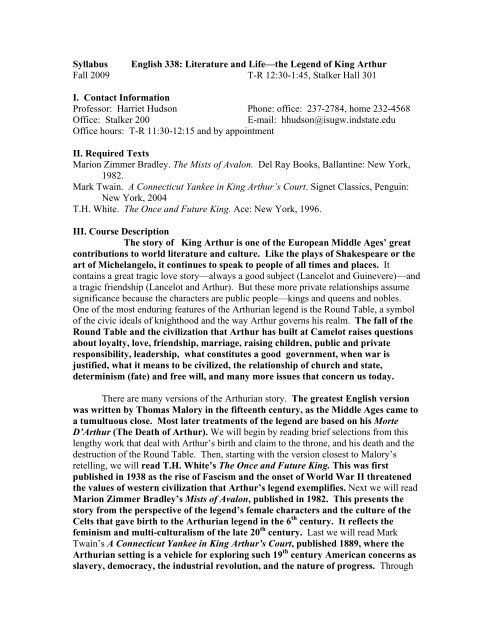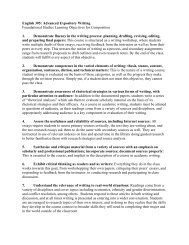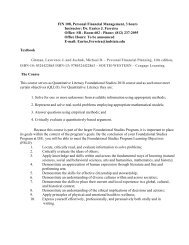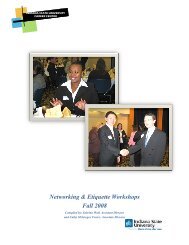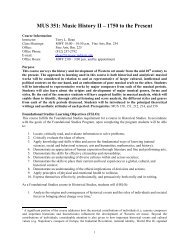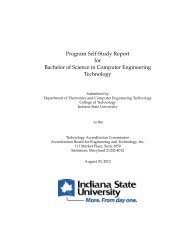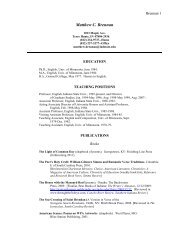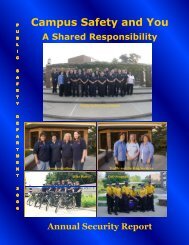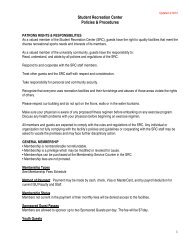English 338 - Indiana State University
English 338 - Indiana State University
English 338 - Indiana State University
You also want an ePaper? Increase the reach of your titles
YUMPU automatically turns print PDFs into web optimized ePapers that Google loves.
Syllabus <strong>English</strong> <strong>338</strong>: Literature and Life—the Legend of King Arthur<br />
Fall 2009 T-R 12:30-1:45, Stalker Hall 301<br />
I. Contact Information<br />
Professor: Harriet Hudson Phone: office: 237-2784, home 232-4568<br />
Office: Stalker 200<br />
E-mail: hhudson@isugw.indstate.edu<br />
Office hours: T-R 11:30-12:15 and by appointment<br />
II. Required Texts<br />
Marion Zimmer Bradley. The Mists of Avalon. Del Ray Books, Ballantine: New York,<br />
1982.<br />
Mark Twain. A Connecticut Yankee in King Arthur’s Court. Signet Classics, Penguin:<br />
New York, 2004<br />
T.H. White. The Once and Future King. Ace: New York, 1996.<br />
III. Course Description<br />
The story of King Arthur is one of the European Middle Ages’ great<br />
contributions to world literature and culture. Like the plays of Shakespeare or the<br />
art of Michelangelo, it continues to speak to people of all times and places. It<br />
contains a great tragic love story—always a good subject (Lancelot and Guinevere)—and<br />
a tragic friendship (Lancelot and Arthur). But these more private relationships assume<br />
significance because the characters are public people—kings and queens and nobles.<br />
One of the most enduring features of the Arthurian legend is the Round Table, a symbol<br />
of the civic ideals of knighthood and the way Arthur governs his realm. The fall of the<br />
Round Table and the civilization that Arthur has built at Camelot raises questions<br />
about loyalty, love, friendship, marriage, raising children, public and private<br />
responsibility, leadership, what constitutes a good government, when war is<br />
justified, what it means to be civilized, the relationship of church and state,<br />
determinism (fate) and free will, and many more issues that concern us today.<br />
There are many versions of the Arthurian story. The greatest <strong>English</strong> version<br />
was written by Thomas Malory in the fifteenth century, as the Middle Ages came to<br />
a tumultuous close. Most later treatments of the legend are based on his Morte<br />
D’Arthur (The Death of Arthur). We will begin by reading brief selections from this<br />
lengthy work that deal with Arthur’s birth and claim to the throne, and his death and the<br />
destruction of the Round Table. Then, starting with the version closest to Malory’s<br />
retelling, we will read T.H. White’s The Once and Future King. This was first<br />
published in 1938 as the rise of Fascism and the onset of World War II threatened<br />
the values of western civilization that Arthur’s legend exemplifies. Next we will read<br />
Marion Zimmer Bradley’s Mists of Avalon, published in 1982. This presents the<br />
story from the perspective of the legend’s female characters and the culture of the<br />
Celts that gave birth to the Arthurian legend in the 6 th century. It reflects the<br />
feminism and multi-culturalism of the late 20 th century. Last we will read Mark<br />
Twain’s A Connecticut Yankee in King Arthur’s Court, published 1889, where the<br />
Arthurian setting is a vehicle for exploring such 19 th century American concerns as<br />
slavery, democracy, the industrial revolution, and the nature of progress. Through


